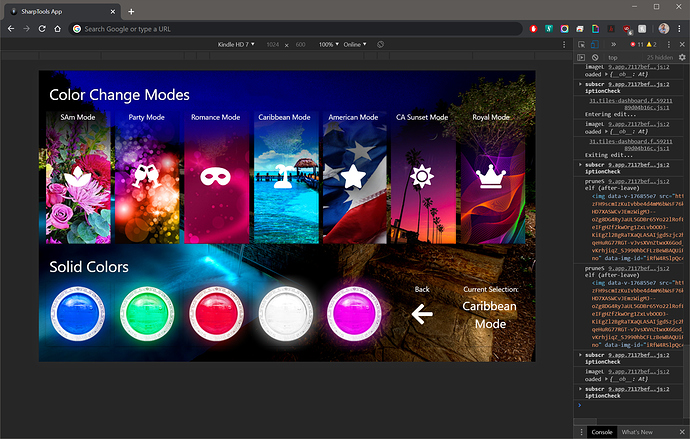Quick update on the Shelly situation:
I got my Shelly in and flashed to tasmota tonight.
Got my RM rule set up:
I had previously, over the weekend, set up a custom dashboard on Sharptools:
--And everything is working beautifully! All I have to do now is wire the Shelly into my Transformer box. The transformer housing has a roomy box in the bottom where 110 comes in, and you have 12V, 13V, or 14V AC out. I will run my Shelly off the 110 coming in and switch the 12V out, and this badboy will be working!
In case anyone wants to know exactly what I have going here:
In Hubitat, I have:
- A virtual button with 14 buttons
- A global variable called IntellibriteColor
- A virtual omni sensor called Pool Light Mode (optional--just feeds a variable to SharpTools)
- A RM Buttoncontroller rule that sets the IntellibriteColor global variable and the omni sensor to whatever button was pushed on the virtual button (ex: pushing button 11 sets IntellibriteColor = 11, Pool Light Mode = Solid White)
- A RM rule (screenshot above) that is triggered by the global variable (IntellibriteColor) changing, and sends an http GET command to the Shelly telling it to set the BlinkCount to %IntellibriteColor%, and to blink the relay.
In SharpTools, I have:
- A dashboard (screenshot above) with 12 modes. Those mode buttons are SharpTools rules that simply send a "push" command to the virtual switch in Hubitat, with the appropriate button #. This allows me to have only ONE device in Hubitat and Sharptools, but to pass 12 (really 14, but I'm not using 2 of them) discrete commands.
- A hero attribute tile for the "Pool Color Mode" virtual omni sensor in Hubitat. This sensor has a custom attribute that I set with a string via one of my rules when a button is pressed. This attribute displays the name of the currently/last selected mode on my SharpTools dashboard
The end result:
I push America mode in my Sharptools dashboard>Sharptools "sends PUSH button 5" on my Hubitat virtual switch>The ButtonController app sets "IntellibriteColor" global variable to 5, and variable in "Pool Light Mode" to "America Mode">Sharptools displays Current selection: "America Mode" via hero attribute tile for Hubitat's "Pool Light Mode" device>Global variable changing to 5 triggers http GET request to the Shelly, telling it to blink the relay 5 times, which turns the light to America mode.
My relay timing is current set to .2 seconds, so switching to America mode should take a little more than 1 second (which is way faster than Hubitat and the PE653 could have managed, and even faster than the ludicrously overpriced Intellibrite Controller does it, from the reviews I've read). But if it ends up needing to be fine tuned, the timing of the blinks can be easily changed via a simple command sent to the Shelly, which is persistent until it is changed again.
The great thing here is that the relay blinks are being controlled directly on-chip by the ESP8266, so the hub overhead is minimal, and the blinks are dead reliable. And, a Shelly costing about $10 gets me the functionality of the Intellibrite controller for about $240 off! 



